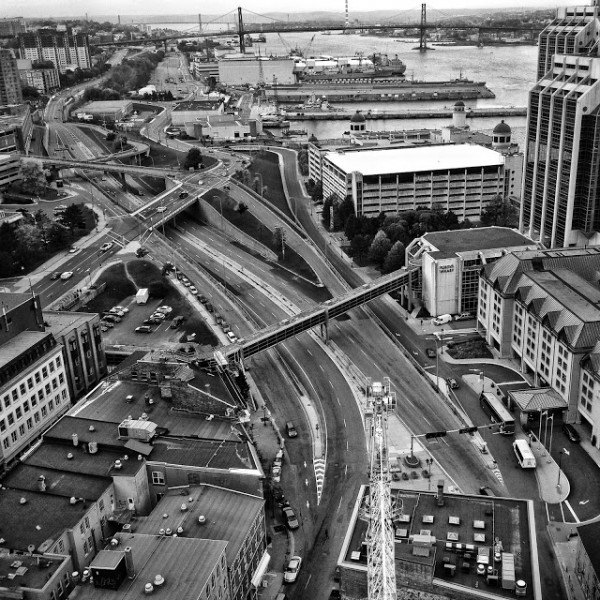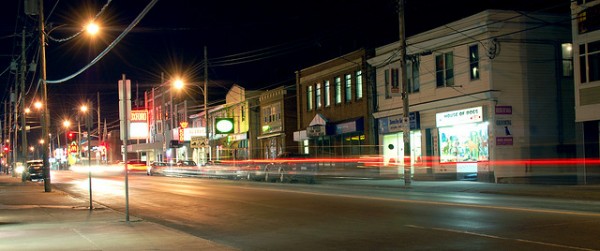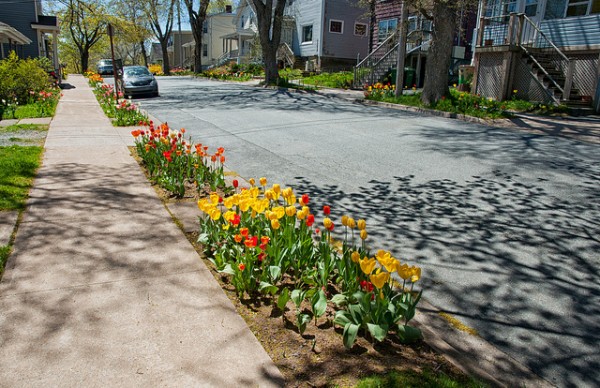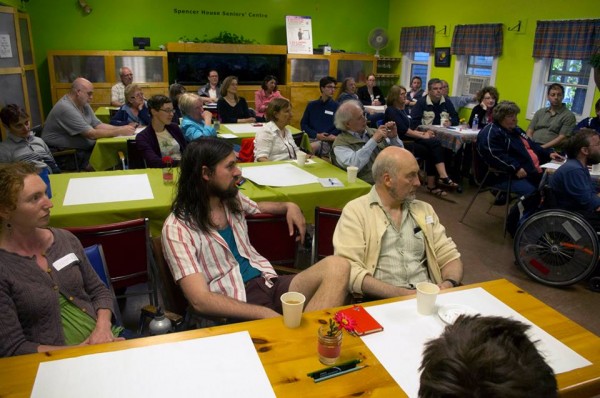HALIFAX – A new year begins. The possibilities seem endless. Opportunities seem ripe for the taking. 2013 offered a lot of promise and, generally, concrete positive results and action plans for HRM.
Key initiatives like its pledge to eliminate homelessness by 2019 are to be lauded, but will 2014 be the year council throws caution to the wind and acts on several transformative projects like the Cogswell Interchange teardown or the re-imagining of Metro Transit?
How can we strengthen the bonds of neighbourhood, community, city, and region?
Throughout the year, Spacing Atlantic will be discussing ideas, big and small, on how to move our city and region forward. The ideas might be new, they might be old, but we hope they will merit your consideration.
To start off, we asked contributors to share their chief highlight from 2013 and what they look forward to in 2014 for Halifax. If you have your own highlights or ideas, please leave us a comment with your thoughts. (Note: I did aim for gender balance, but couldn’t help with how the responses came in.)
Matt Neville
This covers both – something the Province has done that can make the region better and that HRM now has to start using in 2014.
Innovative Transportation Act Legislation
With rigid municipal and provincial engineering and design street standards, public right-of-ways in the city centre of Halifax do not serve all residents equally. While up to 40% of residents on Peninsular Halifax do not own a car, the public right-of-ways (ROWs) are designed as if everyone does. The Innovative Transportation Act permits new street prototypes – demonstration projects that re-imagine our streets in ways that improve access, mobility and experience for those who live here and rely on human-power to get around on a daily basis.
Steffen Käubler
2013 – In a metropolitan region that is as geographically diverse as it is ambiguous about how it wants to grow, and in light of the unresolved complex challenges that loom over the current Regional Plan 5-Year Review, it is the small tangible initiatives that continue to instil a sense of progress and visible transformation. A few feet of granite curb, newly installed at one of Halifax’s busiest downtown intersections across from the much-celebrated new central library, represent one small but resoundingly important sign of an evolving city-building philosophy: an approach that signifies longevity over hastiness, quality over incompleteness and aesthetic excellence over non-descript sameness.
2014 – Quinpool Road, one of Halifax’s great retail avenues, can become a model for complementary and well-timed policies, programs and initiatives. Despite decades characterized by a void in public infrastructure spending — and a resulting undeniable inelegance, Quinpool has prevailed as a remarkably diverse and vibrant shopping district. Its potential, however, is much greater. A few key initiatives could come together in 2014 with promising results: the redevelopment of the former St. Patrick’s High School property, the emergence of solid urban form guidelines from a revived Centre Plan, and the implementation of the suspended Quinpool Road Streetscape Project would collectively turn the street into a captivating demonstration project for the mid-rise intensification of our city’s many great urban corridors.
Diana Chard
2013 – The development of community was one of the best things to occur in 2013. Initiatives such as Switch: Open Streets and I Love Local‘s Open City and City Harvest as well as events at the Park Avenue Community Oven in Dartmouth brought people together and introduced them to amazing local businesses and organizations of which they otherwise might not have been aware.
2014 – We need to make this a leading city in active transportation. Not long ago we were known for our pedestrian-friendly streets. Unfortunately, times have certainly changed. The outrageous number of pedestrians being hit by cars and buses, and the lack of regard for cyclists, is shameful. Not to mention the poor sidewalk clearing so far this winter. I would like to see Halifax return the right-of-way to the pedestrian in 2014 as well as seriously consider the introduction of heated sidewalks.
Chris Miller
2013 – After many years of slow progress, in 2013 the Halifax Regional Municipality finally initiated formal land negotiations to establish the Birch Cove Lakes wilderness park. The Birch Cove Lakes are one of Halifax’s best-kept secrets, a wilderness jewel that’s less than 10km from downtown, with remote lakes and vast tracts of intact forest. The City promised to establish the wilderness park back in 2006 but has made very little progress since that time to make it happen. Let’s hope that the unanimous decision by Regional Council in September to proceed with the land negotiations will finally result in the protection of the Birch Cove Lakes wilderness once-and-for-all.

2014 – The Halifax Regional Municipality needs to follow-through on its promise to establish a wilderness park for the Birch Cove Lakes. This long-overdue commitment to protect Halifax’s near-urban wilderness will be a major achievement for the City if it can successfully negotiate the acquisition of these lands, particularly properties on Susies, Quarry, and Fox Lakes. Formal land negotiations are currently underway and the provincial government has already protected most of the existing public lands here. The Birch Cove Lakes provide close and easy access to a superb wilderness, actually inside the old city limits of Halifax, with great hiking and lots of opportunities for wilderness canoeing and kayaking.
Stephen Cushing
2013 – The HRM has always been a well-treed region, but in the last year we have made significant strides in support of green infrastructure at the policy level. By green infrastructure I mean the natural and planted vegetation in our region that provides us with a broad range of services. Over the last year, residents will have noticed hundreds of new trees planted all over the HRM as well as a new pruning program for trees along streets. There has also been movement in other green infrastructure programs such as stormwater management. This emphasis on vegetation in our community strikes me as the most important because it recognizes the power of vegetation to improve the livability of our region.
2014 – Although the HRM urban forest master plan is a successful plan, it only considers the management of municipally-owned trees. I am in support of programs that educate homeowners, developers, and planning professionals of the importance of maintaining and planting trees on private property, especially, in urban situations where trees frequently make way for the built environment. I would also welcome incentives (e.g. density bonusing, tax breaks) for preservation of urban greenspace on private property.
Sean Gillis
2013 – Turned down Skye Halifax

2014 – We really need to consolidate and update our zoning by-laws to require better development. HRM by Design is in effect in the downtown, but we need comparable regulations in many more areas. Also, fast, frequent, reliable public transit.
Matt Worona
2013 – City Hall’s tone has shifted in the last year. The doors haven’t been blown off the hinges, but a culture of open government and transparency is slowly taking root. I would say the change is similar to propping open a side door to municipal government, but there remains (lots of) room for improvement. Programs like Apps4Halifax and the Open Data project are initiatives that fully embody this changing culture.
2014 – After a string of crosswalk collisions, I think it’s imperative that Halifax flip the current transportation food chain. Council should take strides to ensure walking, cycling and transit are prioritized over single passenger automobiles.
Ben Wedge
2013 – The number one initiative that has happened in the city is the new approach to public engagement. It is impacting a number of items (AT plan, Metro Transit, Budget, Regional Plan, etc.) and is far from perfect, but the point is that the thinking has shifted. It’s not something that we will see desirable results from yet. Citizens, staff, and council have a learning curve to make good use of broad engagement. This will pay dividends as peoples’ trust in the process increases. Perhaps in 2020 we’ll see it working beautifully. Many councillors have taken interest in Councillor Waye Mason’s community fund engagement process as well, I anticipate that format being used on a broader scale, something that is of great benefit to all citizens.
2014 – HRM is due for a civil service reform. This isn’t an easy or “sexy” item that can be put in a press release. The entire culture needs to be shifted from bureaucratic and regulatory to one of helping citizens succeed. With buy-in from leadership it’s possible to change this culture with few, if any, changes to bylaws. When a citizen approaches a staffer with a query, that staffer’s job should be to ensure the query is answered satisfactorily, in a reasonable amount of time. It will involve collaborating across departments and dumbing government down to a level that any citizen can understand. Once we have achieved this, building inspectors will be educators, approval processes will be improved, and all across city government we will have more pleasant interactions and feel capable of achieving great things.
Nat Smith
2013 – HRM Council can be lauded for its efforts to ensure that we have good government – that effective councillors such as Watts and Mason are using their ability to broker to encourage and achieve change in the city. The last year has been a good year because things are getting done.
2014 – We need bold and decisive decision makers – visionaries. Great men and women who are willing to take a stance, stick to it and follow through. Our generation, our era, this period is going to be either be defined by the mediocrity that exists within our society or it will be defined by the ability to gather and use effectively the resources we have available to us to do great things, change the world and make life better.
A city like Halifax has potential, has the resources, has the ability to mobilize to ensure that we aren’t left behind.
David Fleming
2013 – I think our focus on affordable housing has been good – it’s probably the biggest driver away from the urban core today. We need to appreciate the role that income plays in that – 40% of Nova Scotians didn’t get a raise last year and 12% are on social assistance, so even a 1% increase in housing costs comes out of people’s pockets if they’re not making any more money. We need to better understand what drives sustainable growth and know when to act and when to get out of the way.
2014 – Urgency and action over complacency and talk. We’ve been talking about the same problems (demographics, affordability, tax reform, urban core decline, climate change) for most of my adult life – but we keep putting off the tough, sometimes politically unpopular decisions. We can’t expect different results edging at the status quo – it’s time for the community, and for government, to not just talk bold, but act bold.
Kate Watson
2013 – The Stantec Study had people thinking and talking about the benefits of directing growth and curbing sprawl. Extensive council debate during the Regional Plan five-year review lead to the adaptation of a greenbelting policy as one tool for community design and open space planning. Hallelujah!
2014 – Here’s hoping that 2014 sees greater investment in public transit and active transportation. More people in the urban core shouldn’t have to mean more cars there, too.
Sam Austin
2013 – We saw some very encouraging changes in the relationship between the Province and HRM. The outgoing NDP government made good on its promise to finally give HRM the authority to use density-bonusing outside of Downtown Halifax. Then, during the Fall election campaign, our new premier took time out of his schedule to address HRM council directly. He promised to work with the municipality as a partner and respect its jurisdiction.
2014 – My wish list for 2014 is to get the right plans and legislation in place. We need to finalize the Centre Plan to ensure that new development provides the most benefit to the community. This is particularly important in North End Halifax and Downtown Dartmouth. We also need to stop subsidizing development from the existing tax-base. The ground-breaking Stantec Study, finally, identified the true costs of different types of development, but for HRM to recoup the costs of expanding infrastructure and services, the Province needs to amend the HRM Charter.









3 comments
Great to see the calls to action, I couldn’t agree more …
Ben’s point about how municipal staff can adjust their perception of themselves (and their role in the community) is another nice nod to the fact that in many ways we already have what we need to succeed, we just have to take steps toward actualization as a community.
I would say that this shift in attitude is not only needed by municipal staffers, but our colleagues in other level of government and the private sector as well.
And, a hat-tip to HRM’s implementation of the Solar City project throughout 2013, approved by Council in 2012! Can’t wait to see its continuation in 2014!
For 2014 – updating zoning bylaws (Sean’s note) to reflect our 21st century understanding of city growth would be where I’d love to see good effort. Many of our zoning bylaws are based in the 1970’s and attempt to preserve the built form of pre-1950, which are eras that do not reflect how people in HRM say they want to live in our Region.
I think we have a perfect storm of tangible potential and a fabulous Council to get these jobs done well!
Ben Wedge’s comment are most astute. A culture shift within HRM will positively affect everything else.